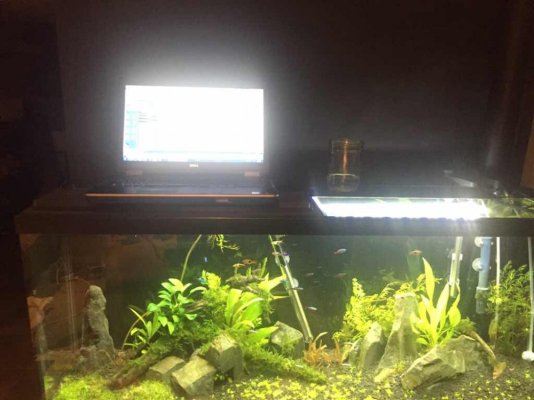You are using an out of date browser. It may not display this or other websites correctly.
You should upgrade or use an alternative browser.
You should upgrade or use an alternative browser.
Algae problems 55g
- Thread starter jrizza
- Start date
The friendliest place on the web for anyone with an interest in aquariums or fish keeping!
If you have answers, please help by responding to the unanswered posts.
If you have answers, please help by responding to the unanswered posts.
fishenthusiast
Aquarium Advice Addict
Do you know what PAR you have? It appears that you have a lot of lighting. Also, plants such as Cryptocoryne and Anubias typically grow too slow for high light tanks--meaning that it is hard to keep algae off of them, unless they are shaded.
Sent from my iPhone using Aquarium Advice
Sent from my iPhone using Aquarium Advice
Caliban07
Aquarium Advice Addict
http://current-usa.com/aquarium-led-lights/satellite-led-fixtures/satellite-freshwater-led-plus/
According to this 20-30 probably measured in air. Seems like pretty low lighting. Hence the perfect balance before co2 shut off for a week.
Sent from my iPhone using Aquarium Advice
According to this 20-30 probably measured in air. Seems like pretty low lighting. Hence the perfect balance before co2 shut off for a week.
Sent from my iPhone using Aquarium Advice
Caliban07
Aquarium Advice Addict
So if the cause was not light or nutrients- it was the carbon supply? If that's the case... Why hasn't it died off yet?
Sent from my iPhone using Aquarium Advice
That is my understanding yes. Has it grown anymore/spread? You can't kill algae by adding co2. It has been triggered to go from spore to flagellate. Now it has found a niche in which it can coexist with higher plants and it is being supported via nutrients light and co2. It needs to be removed or destroyed by other means. H2o2, glut etc. I opt for manual removal personally.
Sent from my iPhone using Aquarium Advice
fishenthusiast
Aquarium Advice Addict
The algae should subside once the tank balances. As Caliban mentioned, kill off the current algae with glut of H2O2 via syringe. Since your lighting isn't that high, pressurized CO2 isn't necessary with the PAR that was listed; although, it is helpful. Since you have the CO2 system, use it and find a balance with ferts and lighting. A boatload of ferts isn't necessary, and if I were you, I would cut down lighting to 6 hours until the algae subsides. Then, you can gradually increase up to 7 or so hours, or stay with 6 if the tank is to your liking. One factor that I haven't seen being discussed is water flow. How is the flow within this tank? Algae loves stagnant water.
Sent from my iPhone using Aquarium Advice
Sent from my iPhone using Aquarium Advice
Has it grown anymore/spread?
yes. Brown algae on gravel, plants and glass near gravel or plants, bba in some places. Cleaned up the start of some green spot algae on the glass yesterday.
I pretty much have a bucket next to my tank, and if I can I will take the affected rock or driftwood out of the tank, scrub it in the bucket, maybe spray it with some h2o2, then I put it back in.
Typically I am taking 30 mins or so every few days doing some sort of cleanup.
I really went through the tank yesterday and removed any plant (including all the crypt) that had algae on it. I was concerned about removing a significant portion of the plant mass at once, but I think if if I am selective about it it will help.
I think I'm going to start focusing on removing rather than cleaning. This feedback has been super helpful in trying to understand the fight! Thank you in advance for your continued feedback.
Now- what about algae on my gravel? What's the best way to tackle that? Blackout?
Sent from my iPhone using Aquarium Advice
Caliban07
Aquarium Advice Addict
yes. Brown algae on gravel, plants and glass near gravel or plants, bba in some places. Cleaned up the start of some green spot algae on the glass yesterday.
I pretty much have a bucket next to my tank, and if I can I will take the affected rock or driftwood out of the tank, scrub it in the bucket, maybe spray it with some h2o2, then I put it back in.
Typically I am taking 30 mins or so every few days doing some sort of cleanup.
I really went through the tank yesterday and removed any plant (including all the crypt) that had algae on it. I was concerned about removing a significant portion of the plant mass at once, but I think if if I am selective about it it will help.
I think I'm going to start focusing on removing rather than cleaning. This feedback has been super helpful in trying to understand the fight! Thank you in advance for your continued feedback.
Now- what about algae on my gravel? What's the best way to tackle that? Blackout?
Sent from my iPhone using Aquarium Advice
Siphon out the top layer of gravel. Spray/soak with glut the rinse, dry and add it again at a later date. Did you add the crushed coral. What is your ph at this point?
Sent from my iPhone using Aquarium Advice
Thrills22
Aquarium Advice Activist
- Joined
- Mar 31, 2016
- Messages
- 114
I've read through this thread and I'm not totally sure if the CO2 injection is back or not. That said, my first encounter with bba was when I started using a DIY CO2 setup. In short, I killed it by switching to a pressurized CO2 setup.
BBA thrives in a setup where CO2 is fluctuating. Once I created a consistent injection the plants themselves shed the BBA. DIatoms are natural in a new setup and will dissapear own their own. Shrimps and apple snails will speed up that process.
BBA thrives in a setup where CO2 is fluctuating. Once I created a consistent injection the plants themselves shed the BBA. DIatoms are natural in a new setup and will dissapear own their own. Shrimps and apple snails will speed up that process.
Caliban07
Aquarium Advice Addict
I've read through this thread and I'm not totally sure if the CO2 injection is back or not. That said, my first encounter with bba was when I started using a DIY CO2 setup. In short, I killed it by switching to a pressurized CO2 setup.
BBA thrives in a setup where CO2 is fluctuating. Once I created a consistent injection the plants themselves shed the BBA. DIatoms are natural in a new setup and will dissapear own their own. Shrimps and apple snails will speed up that process.
I think there is some truth in that co2 causes algae but my thoughts are that it is co2's effect on ph that is the true problem and not directly related to co2.
My hypothesis is this. Normally the aim of co2 injection is to lower the ph by 1 unit to achieve 30ppm. This can often result in undesirable ph levels, especially in low Kh waters. When I say undesirable, what I mean is undesirable in terms of nitrifying bacterial reproduction. Low ph value <6.5 inhibit reproduction of nitrifying bacteria and nitrification stops altogether at 6.0. So as ph is lowered, bacterial life cycles are slowed, therefore in co2 injected tanks uptake of ammonia is primarily down to the plants. Now this is all good and well if the plants are kept healthy enough to do this and their uptake of ammonia matches production.
Now in a case where co2 all of a sudden ceases in a tank that has been kept at a low but stable ph, ph begins to rise and heterotrophic bacteria can very rapidly multiply consuming organics releasing ammonia since nitrifying bacteria are not present in enough numbers due to the previously inhibiting ph level, ammonia can build up. Ammonia, coupled with light and organics is thought to be the cause of algal blooms by many. It is believed that ammonia is the likely trigger for an algal spore to grow.
So co2 injected tanks may not be very stable on the whole because they can lack the backup biological filtration to deal with rises in ammonia. Even large trimming/culling of plants or a co2 imbalance that means the plants uptake of nutrients is slowed may cause this effect and it could be why co2 injected tanks seem to battle algae every now and then.
These are just my thoughts.
Sent from my iPhone using Aquarium Advice
Thrills22
Aquarium Advice Activist
- Joined
- Mar 31, 2016
- Messages
- 114
I think there is some truth in that co2 causes algae but my thoughts are that it is co2's effect on ph that is the true problem and not directly related to co2.
My hypothesis is this. Normally the aim of co2 injection is to lower the ph by 1 unit to achieve 30ppm. This can often result in undesirable ph levels, especially in low Kh waters. When I say undesirable, what I mean is undesirable in terms of nitrifying bacterial reproduction. Low ph value <6.5 inhibit reproduction of nitrifying bacteria and nitrification stops altogether at 6.0. So as ph is lowered, bacterial life cycles are slowed, therefore in co2 injected tanks uptake of ammonia is primarily down to the plants. Now this is all good and well if the plants are kept healthy enough to do this and their uptake of ammonia matches production.
Now in a case where co2 all of a sudden ceases in a tank that has been kept at a low but stable ph, ph begins to rise and heterotrophic bacteria can very rapidly multiply consuming organics releasing ammonia since nitrifying bacteria are not present in enough numbers due to the previously inhibiting ph level, ammonia can build up. Ammonia, coupled with light and organics is thought to be the cause of algal blooms by many. It is believed that ammonia is the likely trigger for an algal spore to grow.
So co2 injected tanks may not be very stable on the whole because they can lack the backup biological filtration to deal with rises in ammonia. Even large trimming/culling of plants or a co2 imbalance that means the plants uptake of nutrients is slowed may cause this effect and it could be why co2 injected tanks seem to battle algae every now and then.
These are just my thoughts.
Really interesting theory...
I guess it could be solved by building up a strong bac colony to begin with. But that's someothing which everyone should look to establish first and foremeost.
In my experience, whenever I've created unstable CO2 up pops bba and that includes running out of CO2 mid light cycle and not being able to replace it for a few days. Again I'm not sure if the OP replaced his CO2 and if so, with what in terms of setup But a two pronged attack (building bacs in another tank and keeping a stable CO2 injection) could work wonders.
Caliban07
Aquarium Advice Addict
Really interesting theory...
I guess it could be solved by building up a strong bac colony to begin with. But that's someothing which everyone should look to establish first and foremeost.
In my experience, whenever I've created unstable CO2 up pops bba and that includes running out of CO2 mid light cycle and not being able to replace it for a few days. Again I'm not sure if the OP replaced his CO2 and if so, with what in terms of setup But a two pronged attack (building bacs in another tank and keeping a stable CO2 injection) could work wonders.
This is only possible if you have a solid Kh. Otherwise your ph will fall. The op ran out of co2 for a week before they noticed. Easily enough time for things to go pear shaped. Before that, there was a perfect balance. The ops Kh is 2.5 and a ph of 6.6 is dangerously close to bacterial inhibition. This is assuming that the test kits are reading true.
Similar thing happened to me where I was injecting co2 a few hours before lights on to saturate the water Column ready for lights on. My Kh was <3 everything was going ok really and my tank was quite dense with plants.
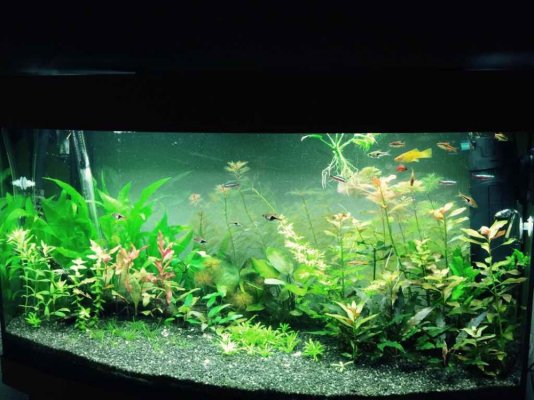
No algae either. But I noticed that my ph was very low 6.0 according to the API test kit but that's as low as it would read and I suspect it may have been lower still. My normal ph is 7.8 measured with a recently purchased ph pen. My fish were showing signs of distress and fin damage. Erratic swimming etc so I stopped injecting co2. If we assume my ph before co2 was 7.8 and at lights on it was 6.0 that is almost 64x acidic than at 7.8. When I stopped injecting I culled some plants and took the reflectors off to compensate. I reintroduced co2 at a third of the rate but the damage had been done. I got a huge bacterial bloom that I can only assume was the growth of heterotrophs and at least 4 types of algae ensued.
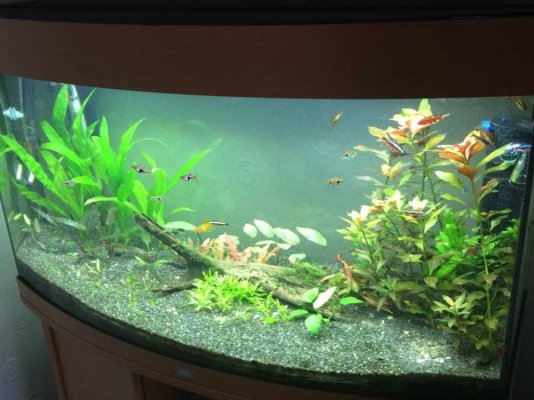
This was after the cull and the following pictures are of the algae.
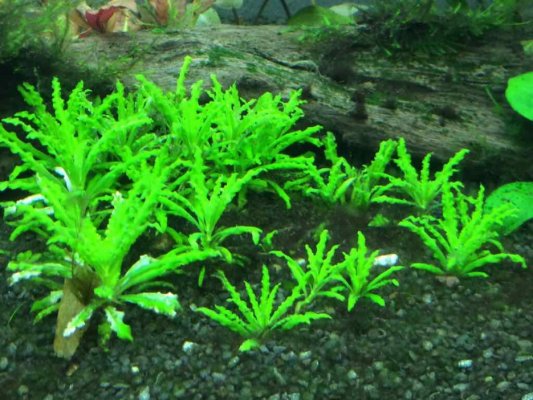
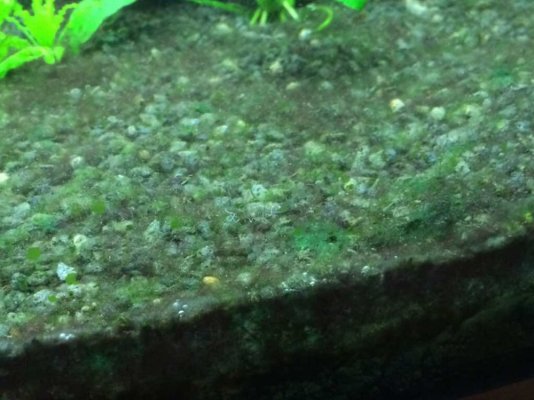
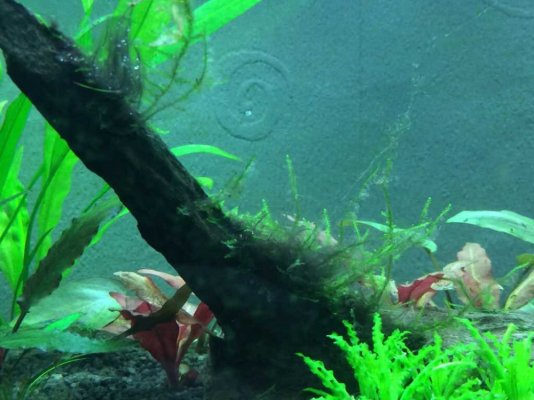
More to follow.
Sent from my iPhone using Aquarium Advice
Caliban07
Aquarium Advice Addict
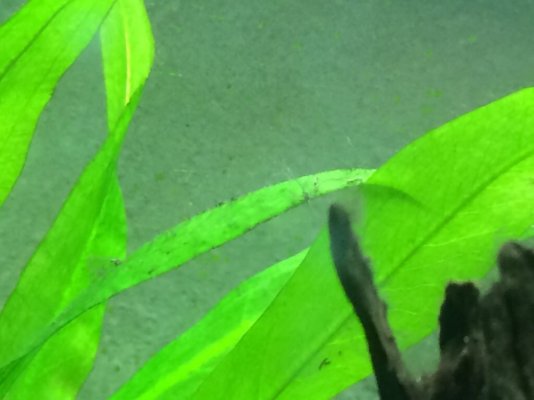
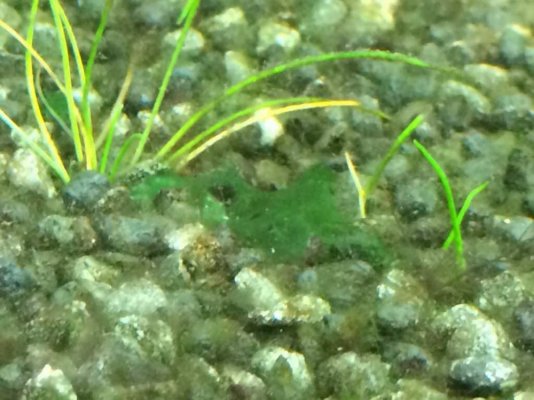
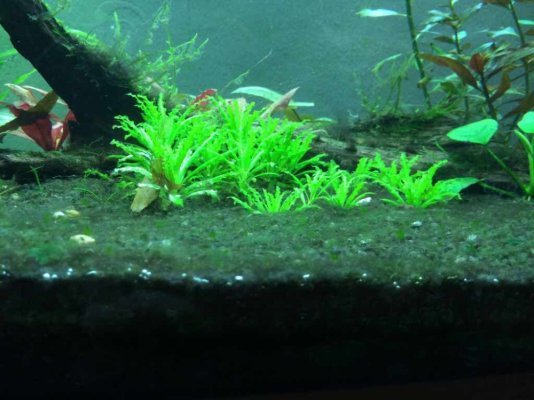
This next one will show you the gravel difference after sucking some out. I couldn't get there because of DHG but in the end the hairgrass had to come out.
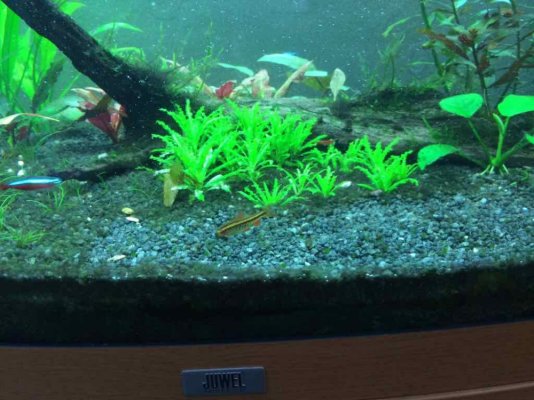
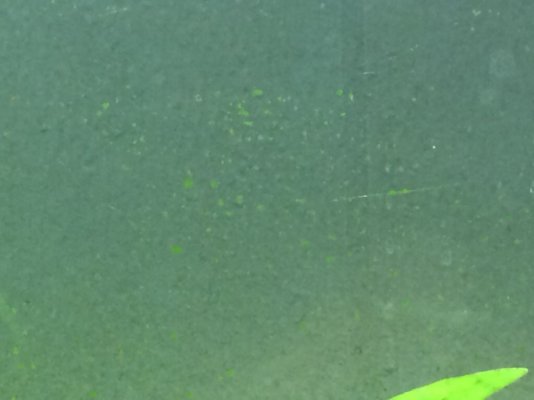
So I'm thinking that if my ph was at 6 at lights on and probably up a bit during the day due to plant consumption I must have had a diminished or diminishing bacterial colony, definitely not a happy one. That's ok if I'd have left the tank and just maybe added some coral to the filter to stabilise ph but I didn't.
This is why I believe that algae observations are made when messing with co2. After all if your plants are dying due to lack of co2 or melting because of a reduced rate of co2 then they will be adding to the ammonia concentration that is no longer being efficiently removed by the healthy plants and because nitrifiers are not there in enough numbers to deal with it, Mr algae takes advantage. I can then only hypothesise that the type of algae is defined by the components within the system I.e ammonia + light + low phosphate = GSA or ammonia + light + high organics + low oxygen = BBA
If you are really good, you can grow them all over night just like me. ?
*please note this is just a hypothesis*
Sent from my iPhone using Aquarium Advice
Thrills22
Aquarium Advice Activist
- Joined
- Mar 31, 2016
- Messages
- 114
*please note this is just a hypothesis*
Yet still a very good hypothesis and throughly good read! Please allow me to digress for a moment and ask which Juwel Vision tank you have, is it a 450L? It looks huge in those pics.
On topic: I firmly believe that one of the most important things about this hobby is often lost when seeking advice. The fact that every tank is different is often factored out of the equation when looking for balance. Even more so when dealing with planted tanks.
Op has a solidset of theories and approaches to choose from.
fishenthusiast
Aquarium Advice Addict
Since the topic of CO2 seems to be main topic of the thread, I thought I'd introduce a video . . .
http://youtu.be/UKZyAK8i_Ek
This guys talks about pH in various parts. Might be worth watching. Maybe it will help the OP too!
Sent from my iPhone using Aquarium Advice
http://youtu.be/UKZyAK8i_Ek
This guys talks about pH in various parts. Might be worth watching. Maybe it will help the OP too!
Sent from my iPhone using Aquarium Advice
Caliban07
Aquarium Advice Addict
Yet still a very good hypothesis and throughly good read! Please allow me to digress for a moment and ask which Juwel Vision tank you have, is it a 450L? It looks huge in those pics.
On topic: I firmly believe that one of the most important things about this hobby is often lost when seeking advice. The fact that every tank is different is often factored out of the equation when looking for balance. Even more so when dealing with planted tanks.
Op has a solidset of theories and approaches to choose from.
This is a juwel vision 180 (180 litres) it probably just looks bigger because of the angle of the photographs but your digression does reinforce your point about factoring of tank difference. For example, it is much more difficult to distribute co2 effectively in a 400 litre aquarium than it is in a 180 litre. The same rule applies in a 180 and a 40 litre.
I think sometimes there is a keen urge to generalise setups when talking on forums or reading articles and in order to find the true cause of something in this hobby especially we need to pay particular attention to the individual setup.
Sent from my iPhone using Aquarium Advice
Thrills22
Aquarium Advice Activist
- Joined
- Mar 31, 2016
- Messages
- 114
We have the same tank lol. The Juwel vision 180L is a sturdy little thing.
And yes to all the above, I made that mistake myself when getting into the hobby. I even made a lot of shrimp purchases based on others experience with shrimp without understanding my own tds etc.
And yes to all the above, I made that mistake myself when getting into the hobby. I even made a lot of shrimp purchases based on others experience with shrimp without understanding my own tds etc.
Well I am rather disappointed in myself. I took readings tonight as not much has changed.
Nighttime readings:
Ph 6 or lower
Kh <1
Nitrate: red. day 4 of EI
I've been adding a little baking soda to buffer kh. Perhaps I need to be adding more or consider adding crushed coral to the canister filter.
Well these are embarrassing readings. I obviously need to be monitoring this scum bucket more closely.
I am prepared to start removing rocks and gravel to start killing this algae. I'm afraid the dwarf hair grass and Staurogyne might have to go. It seems anything near the gravel- or touching the gravel- diatoms will start forming on it.
Bba is spreading and I am seeing it on gravel now.
Weekly I am removing rocks and driftwood and spaying it with h2o2.
Most of it turns red in a day or two and eventually disappears. I'm guessing I'm not killing all of it.
I have a 10gallon tank I am willing to set up as a temporary residence while I attempt to fix this tank. If needed, I can sanitize everything and start over. Perhaps that's what I really need to do. Any suggestions on how to proceed?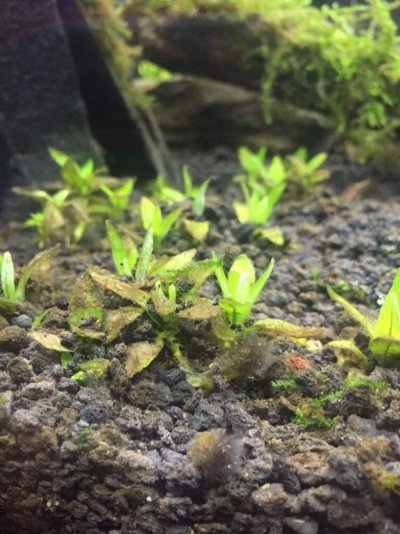
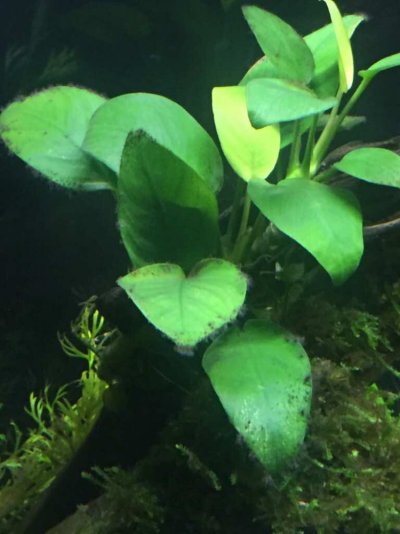
Sent from my iPhone using Aquarium Advice
Nighttime readings:
Ph 6 or lower
Kh <1
Nitrate: red. day 4 of EI
I've been adding a little baking soda to buffer kh. Perhaps I need to be adding more or consider adding crushed coral to the canister filter.
Well these are embarrassing readings. I obviously need to be monitoring this scum bucket more closely.
I am prepared to start removing rocks and gravel to start killing this algae. I'm afraid the dwarf hair grass and Staurogyne might have to go. It seems anything near the gravel- or touching the gravel- diatoms will start forming on it.
Bba is spreading and I am seeing it on gravel now.
Weekly I am removing rocks and driftwood and spaying it with h2o2.
Most of it turns red in a day or two and eventually disappears. I'm guessing I'm not killing all of it.
I have a 10gallon tank I am willing to set up as a temporary residence while I attempt to fix this tank. If needed, I can sanitize everything and start over. Perhaps that's what I really need to do. Any suggestions on how to proceed?


Sent from my iPhone using Aquarium Advice
Similar threads
- Replies
- 3
- Views
- 845
- Replies
- 1
- Views
- 578
- Replies
- 1
- Views
- 2K
- Replies
- 2
- Views
- 797
- Replies
- 188
- Views
- 10K

